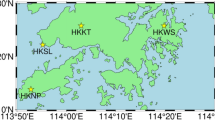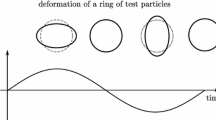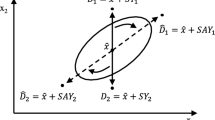Abstract
It is possible to determine the ionospheric scintillation index with a modified NovAtel GPStation-6 dual-frequency GPS/GLONASS receiver by measuring small-scale fluctuations in the total electron content of the ionosphere and calculating their standard deviation. Based on the analysis of the shortcomings of the GPStation-6 receiver, the algorithm for monitoring of small-scale fluctuations of the total electron content based on digital filtering is substantiated. Experimental results of measurement of small-scale fluctuations of the ionospheric total electron content and results of estimation of their root-mean-square deviation and ionospheric scintillation index are presented.










Similar content being viewed by others
Data availability
The datasets generated during and/or analyzed during the current study are available from the corresponding author upon reasonable request.
References
Aarons J (1982) Global morphology of ionospheric scintillations. Proc IEEE 70(4):360–378. https://doi.org/10.1109/proc.1982.12314
Afraimovich EL, Perevalova N (2006) GPS monitoring of the Earth upper atmosphere. Irkutsk
Bogner RE, Constantinides AG (1976) Introduction to digital filtering. Mir, Moscow
Buckley R (1971) Diffraction by a random phase screen with very large rms phase deviation. II. Two-dimensional screen. Aust J Phys 24:373
Carrano CS, Groves KM (2006) The GPS segment of the AFRL-SCINDA global network and the challenges of real-time TEC estimation in the equatorial ionosphere. In: Proc. ION NTM 2006, Institute of Navigation, Monterey, California, USA, January 18–20, pp 1036–1047
Carrano CS, Rino CL (2011) Split-step solution of the 4th moment equation for propagation through intense ionospheric disturbances. In: 2011 International conference on electromagnetics in advanced applications. https://doi.org/10.1109/iceaa.2011.6046387
Carrano CS, Groves KM, Rino CL (2019) On the relationship between the rate of change of total electron content index (ROTI), irregularity strength (CkL), and the scintillation index (S4). J Geophys Res Space Phys 124(3):2099–2112. https://doi.org/10.1029/2018JA026353
Conker RS, El-Arini MB, Hegarty CJ, Hsiao T (2003) Modeling the effects of ionospheric scintillation on GPS/satellite-based augmentation system availability. Radio Sci 38(1):1–23. https://doi.org/10.1029/2000rs002604
Crane RK (1977) Ionospheric scintillation. Proc IEEE 65(2):180–199. https://doi.org/10.1109/proc.1977.10456
Davis K (1969) Ionospheric radio waves. Blaisdell, Waltham, MA
Demyanov V, Sergeeva M, Fedorov M, Ishina T, Gatica-Acevedo VJ, Cabral-Cano E (2020) Comparison of TEC calculations based on trimble, Javad, Leica, and Septentrio GNSS receiver data. Remote Sens 12(19):1–10. https://doi.org/10.3390/rs12193268
Forte B (2008) Refractive scattering evidence from multifrequency scintillation spectra observed at auroral latitudes. Radio Sci 43(02):1–9
Fremouw EJ, Leadabrand RL, Livingston RC, Cousins MD, Rino CL, Fair BC, Long RA (1978) Early results from the DNA wideband satellite experiment—complex-signal scintillation. Radio Sci 13(1):167–187. https://doi.org/10.1029/RS013i001p00167
Fremouw EJ, Secan JA (1984) Modeling and scientific application of scintillation result. Radio Sci 19(3):687–694. https://doi.org/10.1029/RS019i003p00687
Groves K (2004) Monitoring ionospheric scintillation with GPS. In: Colloquium on atmospheric remote sensing using the global positioning system
McCaffrey AM, Jayachandran PT (2019) Determination of the refractive contribution to GPS phase “scintillation.” J Geophys Res Space Phys 124:1454–1469. https://doi.org/10.1029/2018JA025759
Maslov ON, Pashintsev VP (2006) Models of transionospheric radio channels and noise immunity of space communication systems. Append J Infocommun Technol
Novatel Inc. (2012) GPStation-6. GNSS ionospheric scintillation and TEC monitor (GISTM) Receiver User Manual. https://hexagondownloads.blob.core.windows.net/public/Novatel/assets/Documents/Manuals/om-20000132/om-20000132.pdf
Novatel Inc. (2014) OEM6. Firmware reference guide. https://hexagondownloads.blob.core.windows.net/public/Novatel/assets/Documents/Manuals/om-20000129/om-20000129.pdf
Pashintsev V, Kolosov L, Tishkin S, Smirnov A (1999) Influence of the ionosphere on signal detection in space communications systems. J Commun Technol Electron 44(2):132–139
Pashintsev V, Peskov M, Smirnov V, Smirnova E, Tynyankin S (2017) Procedure for extraction of small-scale variations in the total electron content of the ionosphere with the use of transionospheric sounding data. J Commun Technol Electron 62(12):1336–1342
Pashintsev VP, Linets GI, Slyusarev GV, Peskov MV, Melnikov SV (2020) GPS monitoring of small-scale fluctuations of total electron content of ionosphere. Int J Adv Res Eng Technol (IJARET) 11(5)
Pashintsev VP, Peskov MV, Kalmykov IA, Zhuk AP, Senokosov MA (2018) Method for the evaluation of ionospheric diffractive and dispersive properties impact on the interference immunity of satellite communication systems. Int J Civ Eng Technol 9(13):44–61
Pashintsev VP, Shevchenko VA, Boychenko IA, Snedkov DM (2021) Prediction of the scintillation index in a satellite communication channel based on the results of measurements of the parameters of navigation signals. Dual Technol 2(95):41–52
Perevalova NP (2011) Evaluation of the characteristics of a ground-based GPS/GLONASS receiver network designed to monitor ionospheric disturbances of natural and technogenic origin. Sol-Terr Phys 19:124–133
Rytov SM, Kravtsov YN, Tatarsky VI (1978) Introduction to statistical radiophysics. Nauka, Moscow
Shanmugam S, Jones J, MacAulay A, Van Dierendonck AJ (2012) Evolution to modernized GNSS ionoshperic scintillation and TEC monitoring. In: Proceedings of IEEE/ION position, location and navigation symposium (PLANS). IEEE, Myrtle Beach, SC, USA, pp 265–273
Singleton D (1970) Saturation and focusing effects in radio-star and satellite scintillations. J Atmos Terr Phys 32(2):187–208
Yasyukevich YV, Mylnikova A, Kunitsyn V, Padokhin A (2015) Influence of GPS/GLONASS differential code biases on the determination accuracy of the absolute total electron content in the ionosphere. Geomagn Aeron 55:763–769
Yeh KC, Liu C-H (1982) Radio wave scintillations in the ionosphere. Proc IEEE 70(4):324–360. https://doi.org/10.1109/proc.1982.12313
Acknowledgements
The work was carried out with the support of the Russian Science Foundation within the scientific project No. 22-21-00768 (https://rscf.ru/project/22-21-00768) "Methodology for the construction of structural and physical models of trans-ionospheric radio channels and their application to the analysis of satellite radio systems during ionospheric scintillation".
Ethics declarations
Conflict of interest
Authors declare that they have no competing financial interests or other interests that might be perceived to influence the results and/or discussion reported in this paper.
Ethical approval
Not applicable.
Additional information
Publisher's Note
Springer Nature remains neutral with regard to jurisdictional claims in published maps and institutional affiliations.
Rights and permissions
Springer Nature or its licensor (e.g. a society or other partner) holds exclusive rights to this article under a publishing agreement with the author(s) or other rightsholder(s); author self-archiving of the accepted manuscript version of this article is solely governed by the terms of such publishing agreement and applicable law.
About this article
Cite this article
Pashintsev, V.P., Peskov, M.V., Senokosov, M.A. et al. A system for measuring the scintillation index based on the results of monitoring of small-scale fluctuations in the total electron content of the ionosphere. GPS Solut 28, 13 (2024). https://doi.org/10.1007/s10291-023-01550-1
Received:
Accepted:
Published:
DOI: https://doi.org/10.1007/s10291-023-01550-1




